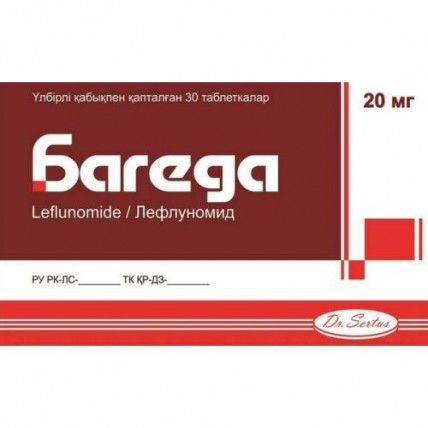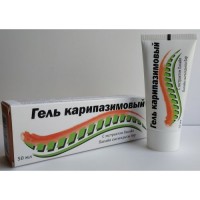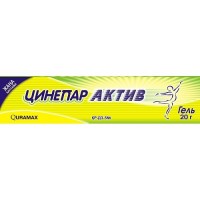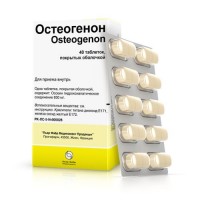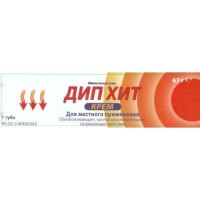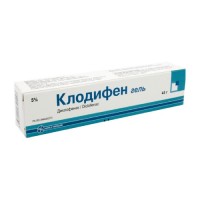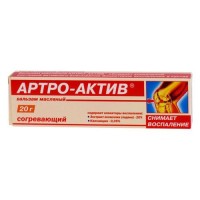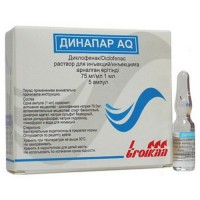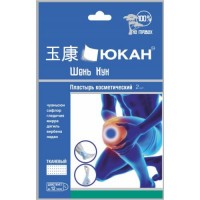Bageda 30s 20 mg film-coated tablets
- $56.10
The instruction for medical use of Bageda Torgovoye medicine Baged Mezhdunarodnoye's name the unlicensed name Leflunomid Lekarstvennaya the Tablet form, film coated Structure One tablet contains active agent - a leflunomid of 10 mg, 20 mg excipients: hydroxypropyl cellulose, lactoses monohydrate, lactose anhydrous, starch corn prezhelatinizirovanny, K30 povidone, magnesium stearate, sodium of starch glikolit, silicon dioxide colloidal anhydrous structure of a cover – for 10 mg, Opadri® II white 85F18422 (the polyvinyl alcohol which is partially hydrolyzed of the titan dioxide (E171), makrogol/PEG, talc). structure of a cover – for 20 mg, Opadri® II yellow 02F22025 (a gipromelloza, a macrogoal 6000, the titan dioxide (E171), ferrous oxide yellow (E172), talc). The description of the Tablet of round shape with a biconvex surface, smooth on both sides, film coated white or almost white color (for a dosage of 10 mg). Tablets of round shape with a biconvex surface, smooth on both sides film coated light yellow color (for a dosage of 20 mg) Pharmacotherapeutic group of Immunodepressanta selection. Leflunomid. The ATX L04AA13 code the Pharmacological Pharmacokinetics Absorption Absorption properties of drug makes 82%-95% and does not depend on meal. Time of achievement of the maximum concentration of A771726 in plasma is variable – from 1 to 24 hours after single use. Elimination half-life makes 2 weeks. Stable concentration of an active metabolite in blood plasma is reached approximately in 2 months at daily reception of the supporting dosages. So, use of a load dose of 100 mg during the first 3 days of therapy allows to reach quickly an equilibrium condition of plasma concentration of an active metabolite of A771726. Pharmacokinetic A771726 parameters have linear dependence at doses on 5 mg to 25 mg. At a dose of 20 mg a day the average plasma concentration of A771726 makes 35 mkg/ml. Concentration of drug in blood plasma at multiple dose increases at 33-35 times in comparison with single dose. Distribution In A771726 plasma quickly and almost for 100% contacts proteins (untied fraction A771726 makes 0.62%). At patients with a pseudorheumatism and chronic kidney disease the linking with proteins of plasma can decrease. Biotransformation Leflunomid is metabolized to one main (A771726) and several minor metabolites, including 4 trifluoromethylalanine. Biotransformation of a leflunomid in A771726 and the subsequent metabolism of the A771726 are controlled by several enzymes and happen in microsomal and cytosolic cellular fractions. Interaction researches with Cimetidinum (nonspecific inhibitor of P450 cytochrome) showed that CYP enzymes are involved by in Vivo in metabolism of a leflunomid only in insignificant degree. Removal Removal of A771726 from an organism slow is also characterized by clearance of 31 ml/hour. Elimination half-life makes about 2 weeks. Leflunomid is brought with excrements due to biliary excretion and with urine. The main metabolites in urine are glucuronides of a leflunomid and derivatives of A771726. The main metabolite in excrements is A771726. The renal failure A771726 Pharmacokinetics at the patients who are on chronic out-patient peritoneal dialysis is similar that at healthy volunteers. Hepatic insufficiency Data on drug pharmacokinetics at patients with a liver failure are absent. Advanced age At patients of advanced age (65 years are also more senior) the pharmacokinetic data correspond to an average age group. The pharmacodynamics the Drug Bageda belongs to a class of basic antirheumatic drugs and has anti-proliferative, immunomodulatory, immunosuppressive and anti-inflammatory properties. The active metabolite of a leflunomid of A771726 inhibits enzyme degidroorotat dehydrogenase and has anti-proliferative activity. Leflunomid reduces symptoms and slows down progressing of damage of joints at an active form of rheumatoid and psoriasis arthritis. The therapeutic effect is usually shown in 4-6 weeks and Indications Treatment of adult patients can accrue further for 4-6 months with: - an active form of a pseudorheumatism as basic means for the purpose of reduction of symptoms of a disease and an arrest of development of structural injuries of joints, - an active form of psoriasis arthritis. The route of administration and doses Treatment should be begun and carried out under control of the experts having experience in treatment of a pseudorheumatism and psoriasis arthritis. Activity of alaninaminotranspherase (ALT) or glyutamopiruvat transferases (GPT) in serum and the general blood test, including a differential picture of leukocytes and number of thrombocytes, it is necessary to control during treatment and with an identical frequency: - before an initiation of treatment the drug Bageda - each two weeks within the first six months of treatment - each 8 weeks subsequently. The drug is taken inside, swallowing entirely, washing down with enough liquid, regardless of meal. Treatment is begun with single dose in a shock dose in 100 mg within 3 days. As a maintenance dose in a pseudorheumatism the reception from 10 mg to 20 mg of a leflunomid is recommended once a day, in psoriasis arthritis – 20 mg of 1 times a day. The therapeutic effect is usually shown in 4-6 weeks and can increase further up to 4-6 months. Corrections of a dose for patients are more senior than 65 years it is not required. Side effects Often - slight increase of arterial blood pressure - a leukopenia (number of leukocytes & gt, 2×109/л) - paresthesias, a headache, dizziness, peripheral neuropathy - diseases of a mucous membrane of an oral cavity: aphthous stomatitis, an ulceration of an oral cavity, nausea, vomiting, an abdominal pain, diarrhea - the strengthened hair loss, eczema, rash, including makulo-papular, an itching, xeroderma - tendosinovit - increase in level creatine phosphokinase (KFK) - anorexia, insignificant loss of body weight, an asthenia - mild allergic reactions - increase in indicators of hepatic function
Infrequently - anemia, insignificant thrombocytopenia (number of thrombocytes & lt, 100 ×109/л) - a hypopotassemia, a lipidemia, a hypophosphatemia - the increased uneasiness - disturbances of flavoring feelings - a small tortoiseshell - a rupture of sinews Seldom - increase in susceptibility to infections, including opportunistic (in particular, rhinitis, bronchitis and pneumonia) and also heavy infections, including sepsis with a possible lethal outcome - a pancytopenia (due to anti-proliferative action), a leukopenia (number of leukocytes & lt, 2 g/l), an eosinophilia - increase in level of a lactate dehydrogenase (LDG) - a severe form of increase in arterial blood pressure - an interstitial pulmonary disease, including an interstitial pneumonitis, with a possible lethal outcome. Cough and short wind can form the basis for cancellation of therapy and carrying out further inspection - hepatitis, jaundice (cholestasia) Very seldom - an agranulocytosis - heavy anaphylactic (anaphylactoid) reactions, a vasculitis, including a skin necrotizing vasculitis - pancreatitis - a liver failure, acute necrosis of a liver which can lead to a lethal outcome - a toxic epidermal necrolysis, a syndrome Stephens-Johnson, a mnogoformny erythema. In case of similar reactions from skin and/or mucous membranes it is necessary to cancel Bagedu and another, possibly connected with these reactions medicines, and at once to start the procedure of full washing away. Repeated use of Bageda in such cases is contraindicated. The recent, accompanying or following one after another use of potentially miyelotoksichny means can be followed by high risk of hematologic effects. It is not known - a hypolithemia - a renal failure - insignificant (reversible) decrease in concentration of sperm, total number of spermatozoa and fast forward mobility - danger of development of malignant new growths of, especially, limfoproliferativny changes, increases at reception of some immunosuppressive agents - a skin lupus erythematosus, pustular psoriasis or the aggravated psoriasis, medicinal reaction with an eosinophilia and system manifestations of the Contraindication - hypersensitivity to active ingredient (especially, in case of a syndrome Stephens-Johnson, a toxic epidermal necrolysis, a poliformny erythema in the anamnesis), to the main active metabolite of a teriflunomid or to any of drug components - patients with an abnormal liver function - patients with heavy immunodeficiency (for example, AIDS) - patients with significant dysfunction of marrow or with the considerable anemia, a leukopenia, a neutropenia or thrombocytopenia caused by others, than rheumatoid or psoriasis arthritis, the reasons - patients with heavy infections (see. "Special instructions") - patients with a moderate or heavy renal failure owing to insufficient clinical experience of use in this group of patients - patients with a heavy hypoproteinemia (including at a nephrotic syndrome) - pregnant women and women of childbearing age who do not apply reliable contraceptives during treatment by Bageda and after it when plasma concentration of an active metabolite are higher than 0.02 mg/l. Before beginning treatment by Bageda, it is necessary to exclude pregnancy existence - the breastfeeding period Medicinal interactions Strengthening of by-effects can take place in case of the recent or accompanying use gepatotoksichny (including alcohol) or gematotoksichny and immunosuppressive drugs or when intake of these drugs is begun after treatment leflunomidy without the washings procedure. At patients a pseudorheumatism no pharmacokinetic interaction between leflunomidy (10 – 20 mg a day) and a methotrexate was revealed (10 – 25 mg a week). The patients accepting leflunomid are recommended not to give Colestyraminum or activated carbon as it leads to fast and considerable decrease in concentration of A771726 (active metabolite of a leflunomid) in blood plasma. It is considered that it is caused by disturbance of recirculation of A771726 in a liver and a small intestine and/or disturbance of its gastrointestinal dialysis. If the patient already accepts NPVS and/or corticosteroids, they can continue to be accepted after an initiation of treatment leflunomidy. The enzymes participating in metabolism of a leflunomid and its metabolites are definitely not known. The research in Vivo of its interaction with Cimetidinum (not specific inhibitor of P450 cytochrome) showed lack of significant interaction. After the accompanying introduction of a single dose of a leflunomid to the subjects receiving repeated doses of rifampicin (not specific inductor of P450 cytochrome), peak A771726 levels increased approximately by 40% whereas the area under a curve the concentration time significantly did not change. The mechanism of this effect is not clear. The researches in vitro showed that A771726 oppresses activity of P4502C9 (CYP2C9) cytochrome. In clinical trials no problems at joint introduction of a leflunomid and NPVS, the metabolized CYP2C9 were observed. With extra care it is necessary to give leflunomid together with other means which are not NPVS which are metabolized by means of CYP2C9 such as Phenytoinum, warfarin and tolbutamide. It was reported about increase in a prothrombin time at co-administration of a leflunomid and warfarin. In a research in which leflunomid gave to female healthy volunteers together with the three-phase oral contraceptives containing 30 mkg of ethinylestradiol of any decrease in contraceptive effect of tablets it was revealed not, and A771726 pharmacokinetics completely kept within the provided range. Now there are no data of rather combined use of a leflunomid with the antimalarial drugs used in rheumatology (for example, chloroquine and hydroxychlorine), the drugs Au (intramusculary or orally), D-Penicillaminum, Azathioprinum and other immunosuppressive medicines (except for a methotrexate). The risk connected with performing complex therapy, especially at long-term treatment is unknown. As such therapy can lead to development of additional or even synergistic toxicity (for example, gepato- or gematotoksichnost), combinations of this drug with other basic drugs (for example, a methotrexate) are undesirable. The recent accompanying or subsequent use of potentially miyelotoksichny agents can be connected with bigger degree of risk of hematologic influences. Immunodepressants increase risk of developing infections and also malignant, especially limfoproliferativny diseases. Vaccination Is not present any clinical data on effectiveness and safety of vaccination in the conditions of treatment leflunomidy. Nevertheless, it is not recommended to carry out vaccination by live vaccines. It is necessary to consider long elimination half-life of the drug Bageda when planning vaccination by live vaccine after drug withdrawal of Baged. Special instructions in case of heavy hematologic reactions, including pancytopenias, it is necessary to cancel Bagedu and any used at the same time myelosuppressive drugs and to begin procedures for washing away of a leflunomid. Transition to other treatment As Bageda has property of long preservation in an organism, transfer of the patient to other MBPRS (for example, a methotrexate) without holding a procedure of removal (washing away) of drug from an organism can increase risk of development of heavy by-effects, therefore, the initiation of treatment leflunomidy has to be considered taking into account these advantages and risks. Careful observation of the patient is recommended even after a long time from the moment of the translation (for example, kinetic interactions, organ toxicity). Recent treatment hepatotoxic or gematotoksichesky MBPRS (for example, a methotrexate) can lead to increase in risk of development of heavy side effects therefore introduction of treatment by Bageda needs to be weighed carefully taking into account advantage and risk, and at first after transition to other therapy it is recommended to carry out more strict monitoring. Skin reactions in case of developing of a stomacace, it is necessary to stop use of a leflunomid. Seldom or never at the patients using leflunomid Stephens-Donson's syndrome or toxic epidermal necrosis and a medicinal allergy with an eosinophilic leukocytosis and system symptoms (LAESS) was shown. As soon as skin and/or mucous reactions which increase suspicions of similar heavy reactions are shown, it is necessary to stop use of the drug Bageda and any other medicine and to execute removal of a leflunomid. Full removal of drug is the basic in most cases. In such cases contraindicated secondary use of a leflunomid. After use of a leflunomid it was not recorded cases of pustulous psoriasis and deterioration in psoriasis. The termination of treatment has to be carried out taking into account a case history and the anamnesis. Infections Bageda's Use can increase susceptibility of patients to infections, including opportunistic, owing to immunosuppressive properties. Infections can have more difficult character and, therefore, demand early and intensive treatment. In case of development of heavy, uncontrollable infections the interruption of treatment by Bageda and need to begin a procedure for washing away of drug from an organism as it is described below can be necessary. At the patients receiving leflunomid among other immunosuppressors exceptional cases of the progressing multifocal leukoencephalopathy were registered. Before an initiation of treatment, all patients have to be estimated on presence of the active and healed (latent) tuberculosis. It can include a case history, possible previous contacts with carriers of tuberculosis and/or if it is necessary, they have to have examination (X-ray of lungs, tuberculin test and/or the analysis interferon scale). Health workers have to remember risk of false-negative results of tuberculin skin test, especially at is heavy
the sick patients or patients having an immunodeficient disease. The patients having tuberculosis have to be under careful observation because of a possibility of reactivation of an infection. Respiratory reactions it was revealed during treatment leflunomidy. The risk of developing of an interstitial disease of lungs increases at patients, having this disease in the anamnesis. The interstitial disease of lungs is potentially fatal disease which can sharply be shown during treatment. Pulmonary symptoms, such as cough and short wind, respectively, can cause cancellation of treatment and a further research. A peripheral neuropathy Cases of a peripheral neuropathy met at the patients receiving the drug Bageda. After the drug Bageda use termination, at most of patients the improvement of a state was observed. Nevertheless, some had resistant symptoms of a neuropathy. At people 60 years having the accompanying neurotoxic treatment and diabetes are more senior, the risk of emergence of a peripheral neuropathy can increase. If the patient taking the drug Bageda has a peripheral neuropathy, it is necessary to stop use of the drug Bageda and to perform the procedure of clarification of an organism from medicine. Blood pressure. Before an initiation of treatment the drug Bageda it is necessary to check arterial blood pressure of blood and further periodically to check it. Sick men have to know birth (recommendations for men) about the possible toxicity for a fruit transmitted through the father. It is also necessary to provide reliable contraception during treatment leflunomidy. Special data on the risk of toxicity for a fruit transmitted through the father no. For minimizing of possible risk the termination of reception of Bageda and reception of a holestiramin on 8 g, 3 times a day, within 11 days or on 50 g of powder of activated carbon, 4 times a day, within 11 days can be required by the men wishing to have the child. In the beginning measure concentration of an active metabolite of A771726 in blood plasma. In 14 days the plasma concentration of A771726 is defined again. When both concentration are lower than 0.02 mg/l, after the expectation period 3 months the risk of a fetotoksichnost is very small. Removal of drug from an organism Is recommended to use (washing away) on 8 g of Colestyraminum 3 times a day. Otherwise, on 50 g of activated carbon 4 times a day. The period of full washing usually is 11 days. The period can be changed depending on clinical or laboratory indicators. Lactose the Drug Bageda contains lactose. Patients with rare hereditary diseases of intolerance of glucose, a lactose intolerance of Lapp or a syndrome of malabsorption of glucose and a galactose, it is not necessary to take this medicine. Pregnancy the Active metabolite of a leflunomid of A771726 is teratogenic for rats and rabbits, can cause heavy defects of development of the person therefore the drug Bageda is contraindicated during pregnancy. Women of childbearing age have to use effective remedies of contraception during treatment and within 2 years after the end of treatment (see. "The waiting period") or up to 11 days after the end of treatment (see. "Procedure of washing away"). Before beginning treatment by Bageda, it is necessary to exclude pregnancy. It is necessary to warn patients that in case of any delay of periods or in the presence of any other reason allowing to assume pregnancy existence they need to report about it at once to the doctor to make the test for pregnancy. If it is positive, then the doctor and the patient have to discuss risk to which pregnancy is exposed. It is possible that fast decrease in concentration of an active metabolite in blood by means of the procedure of removal of medicine from an organism described below at the first delay of periods can reduce risk to which the fruit from a leflunomid is exposed. The women who are on treatment by Bageda and the person interested to become pregnant, are recommended to carry out one of the following procedures to be sure that the fruit will not be affected by toxic concentration of A771726 (the planned concentration is lower than 0.02 mg/l). Waiting period: It is expected that for a long time concentration of A771726 in blood plasma can exceed 0.02 mg/l. It is expected that its concentration decreases to level below 0.02 mg/l after 2 years after the termination of treatment by Bageda. The first time concentration of A771726 in plasma is measured after the 2-year period of waiting. Further, not earlier than through the 14-day period it is necessary to measure concentration of A771726 in plasma again. If both measurements showed concentration lower than 0.02 mg/l, then the teratogenic risk is not expected. The procedure of washing away After the termination of treatment by Bageda: - holestiramin 3 times a day within 11 days accept in a dose 8 g, - as an alternative accept 50 g of powder of activated carbon, 4 times a day, within 11 days. After any of procedures of washing away the control by two separate tests with an interval not less than 14 days and observance of the half-month period of waiting between the first indicator of plasma concentration lower than 0.02 mg/l and fertilization is necessary. Women of childbearing age need to be informed of need of observance of the 2-year period of waiting after the termination of treatment by Bageda before they can become pregnant. If the period of waiting lasting about 2 years in the conditions of reliable contraception is unacceptable, it is possible to advise the preventive procedure of washing away. Holestiramin and activated carbon can influence absorption of estrogen and progestogens therefore reliability of contraception during the procedure of washing away by means of a holestiramin or powder of activated carbon cannot be guaranteed by oral drugs. It is recommended to use alternative methods of contraception. Features of influence of medicine on ability to run the vehicle or potentially dangerous mechanisms in case of side effects, such as dizziness, the ability of the patient to concentration of attention and proper responses can be broken. In such cases the patient needs to refrain from driving and working mechanisms. Overdose Symptoms. The patients receiving leflunomid in the dose, to 5 times exceeding the recommended daily dose and also messages about acute overdose at adults and children had messages about chronic overdose. In most cases the overdose was not reported about development of the undesirable phenomena. The arising undesirable phenomena were comparable to a profile of safety of a leflunomid. Diarrhea, an abdominal pain, a leukopenia, anemia and increase in indicators of tests of a functional condition of a liver were the most often observed undesirable phenomena. Treatment. In case of overdose or toxicity it is recommended to accept Colestyraminum or activated carbon to accelerate clarification of an organism. These washings procedures can be repeated according to clinical indications. Researches with a hemodialysis and COPPD (chronic out-patient peritoneal dialysis) specify that A771726, the main metabolite of a leflunomid, is not capable to be removed by dialysis the Form of release and packing On 10 tablets place in blister strip packaging from a film of polyvinylchloride and aluminum foil. On 3 planimetric packs together with the instruction for medical use in the state and Russian languages place Storage conditions in a cardboard pack to Store in the place protected from light at a temperature not above 25 °C to Store out of children's reach! 3 years not to apply a period of storage after an expiration date. Prescription status According to the prescription the Producer "Uorld Meditsin Ilach Sang. ve Tidzh. A.Sh.", Turkey Address: Istanbul, Bagdzhylar Ilchesi, Gyuneshli, Evren Makhallesi, Dzhami to the Dzhad Yole. No. 50 K. 1B Zemin 4-5-6, Turkey Owner of the registration certificate of Dr. Sertus Ilach Sanayi Ve Tidzharet Limited Shirketi, Turkey Address: 34212 Evren Makhallesi, Dzhami Yolu Dzhaddesi No. 50. Girish Kat. Gyuneshli. Bagdzhylar. Istanbul. Turkey the Name, the address and a contact information (phone, the fax, electronic mails) the organizations of the claim (offer) on quality of medicines accepting in the territory of the Republic of Kazakhstan from consumers and responsible for post-registration observation of safety of medicine. TROKA-S PHARMA LLP, Almaty, Suyunbaya Avenue 222-b ph. 8+7 727 251 99 35, +7 727 251 99 45 fax: 8+7 727 252 90 90 +7 701 786 33 98 (24-hour access) pvpharma@worldmedicine.kz.
To develop
Infrequently - anemia, insignificant thrombocytopenia (number of thrombocytes & lt, 100 ×109/л) - a hypopotassemia, a lipidemia, a hypophosphatemia - the increased uneasiness - disturbances of flavoring feelings - a small tortoiseshell - a rupture of sinews Seldom - increase in susceptibility to infections, including opportunistic (in particular, rhinitis, bronchitis and pneumonia) and also heavy infections, including sepsis with a possible lethal outcome - a pancytopenia (due to anti-proliferative action), a leukopenia (number of leukocytes & lt, 2 g/l), an eosinophilia - increase in level of a lactate dehydrogenase (LDG) - a severe form of increase in arterial blood pressure - an interstitial pulmonary disease, including an interstitial pneumonitis, with a possible lethal outcome. Cough and short wind can form the basis for cancellation of therapy and carrying out further inspection - hepatitis, jaundice (cholestasia) Very seldom - an agranulocytosis - heavy anaphylactic (anaphylactoid) reactions, a vasculitis, including a skin necrotizing vasculitis - pancreatitis - a liver failure, acute necrosis of a liver which can lead to a lethal outcome - a toxic epidermal necrolysis, a syndrome Stephens-Johnson, a mnogoformny erythema. In case of similar reactions from skin and/or mucous membranes it is necessary to cancel Bagedu and another, possibly connected with these reactions medicines, and at once to start the procedure of full washing away. Repeated use of Bageda in such cases is contraindicated. The recent, accompanying or following one after another use of potentially miyelotoksichny means can be followed by high risk of hematologic effects. It is not known - a hypolithemia - a renal failure - insignificant (reversible) decrease in concentration of sperm, total number of spermatozoa and fast forward mobility - danger of development of malignant new growths of, especially, limfoproliferativny changes, increases at reception of some immunosuppressive agents - a skin lupus erythematosus, pustular psoriasis or the aggravated psoriasis, medicinal reaction with an eosinophilia and system manifestations of the Contraindication - hypersensitivity to active ingredient (especially, in case of a syndrome Stephens-Johnson, a toxic epidermal necrolysis, a poliformny erythema in the anamnesis), to the main active metabolite of a teriflunomid or to any of drug components - patients with an abnormal liver function - patients with heavy immunodeficiency (for example, AIDS) - patients with significant dysfunction of marrow or with the considerable anemia, a leukopenia, a neutropenia or thrombocytopenia caused by others, than rheumatoid or psoriasis arthritis, the reasons - patients with heavy infections (see. "Special instructions") - patients with a moderate or heavy renal failure owing to insufficient clinical experience of use in this group of patients - patients with a heavy hypoproteinemia (including at a nephrotic syndrome) - pregnant women and women of childbearing age who do not apply reliable contraceptives during treatment by Bageda and after it when plasma concentration of an active metabolite are higher than 0.02 mg/l. Before beginning treatment by Bageda, it is necessary to exclude pregnancy existence - the breastfeeding period Medicinal interactions Strengthening of by-effects can take place in case of the recent or accompanying use gepatotoksichny (including alcohol) or gematotoksichny and immunosuppressive drugs or when intake of these drugs is begun after treatment leflunomidy without the washings procedure. At patients a pseudorheumatism no pharmacokinetic interaction between leflunomidy (10 – 20 mg a day) and a methotrexate was revealed (10 – 25 mg a week). The patients accepting leflunomid are recommended not to give Colestyraminum or activated carbon as it leads to fast and considerable decrease in concentration of A771726 (active metabolite of a leflunomid) in blood plasma. It is considered that it is caused by disturbance of recirculation of A771726 in a liver and a small intestine and/or disturbance of its gastrointestinal dialysis. If the patient already accepts NPVS and/or corticosteroids, they can continue to be accepted after an initiation of treatment leflunomidy. The enzymes participating in metabolism of a leflunomid and its metabolites are definitely not known. The research in Vivo of its interaction with Cimetidinum (not specific inhibitor of P450 cytochrome) showed lack of significant interaction. After the accompanying introduction of a single dose of a leflunomid to the subjects receiving repeated doses of rifampicin (not specific inductor of P450 cytochrome), peak A771726 levels increased approximately by 40% whereas the area under a curve the concentration time significantly did not change. The mechanism of this effect is not clear. The researches in vitro showed that A771726 oppresses activity of P4502C9 (CYP2C9) cytochrome. In clinical trials no problems at joint introduction of a leflunomid and NPVS, the metabolized CYP2C9 were observed. With extra care it is necessary to give leflunomid together with other means which are not NPVS which are metabolized by means of CYP2C9 such as Phenytoinum, warfarin and tolbutamide. It was reported about increase in a prothrombin time at co-administration of a leflunomid and warfarin. In a research in which leflunomid gave to female healthy volunteers together with the three-phase oral contraceptives containing 30 mkg of ethinylestradiol of any decrease in contraceptive effect of tablets it was revealed not, and A771726 pharmacokinetics completely kept within the provided range. Now there are no data of rather combined use of a leflunomid with the antimalarial drugs used in rheumatology (for example, chloroquine and hydroxychlorine), the drugs Au (intramusculary or orally), D-Penicillaminum, Azathioprinum and other immunosuppressive medicines (except for a methotrexate). The risk connected with performing complex therapy, especially at long-term treatment is unknown. As such therapy can lead to development of additional or even synergistic toxicity (for example, gepato- or gematotoksichnost), combinations of this drug with other basic drugs (for example, a methotrexate) are undesirable. The recent accompanying or subsequent use of potentially miyelotoksichny agents can be connected with bigger degree of risk of hematologic influences. Immunodepressants increase risk of developing infections and also malignant, especially limfoproliferativny diseases. Vaccination Is not present any clinical data on effectiveness and safety of vaccination in the conditions of treatment leflunomidy. Nevertheless, it is not recommended to carry out vaccination by live vaccines. It is necessary to consider long elimination half-life of the drug Bageda when planning vaccination by live vaccine after drug withdrawal of Baged. Special instructions in case of heavy hematologic reactions, including pancytopenias, it is necessary to cancel Bagedu and any used at the same time myelosuppressive drugs and to begin procedures for washing away of a leflunomid. Transition to other treatment As Bageda has property of long preservation in an organism, transfer of the patient to other MBPRS (for example, a methotrexate) without holding a procedure of removal (washing away) of drug from an organism can increase risk of development of heavy by-effects, therefore, the initiation of treatment leflunomidy has to be considered taking into account these advantages and risks. Careful observation of the patient is recommended even after a long time from the moment of the translation (for example, kinetic interactions, organ toxicity). Recent treatment hepatotoxic or gematotoksichesky MBPRS (for example, a methotrexate) can lead to increase in risk of development of heavy side effects therefore introduction of treatment by Bageda needs to be weighed carefully taking into account advantage and risk, and at first after transition to other therapy it is recommended to carry out more strict monitoring. Skin reactions in case of developing of a stomacace, it is necessary to stop use of a leflunomid. Seldom or never at the patients using leflunomid Stephens-Donson's syndrome or toxic epidermal necrosis and a medicinal allergy with an eosinophilic leukocytosis and system symptoms (LAESS) was shown. As soon as skin and/or mucous reactions which increase suspicions of similar heavy reactions are shown, it is necessary to stop use of the drug Bageda and any other medicine and to execute removal of a leflunomid. Full removal of drug is the basic in most cases. In such cases contraindicated secondary use of a leflunomid. After use of a leflunomid it was not recorded cases of pustulous psoriasis and deterioration in psoriasis. The termination of treatment has to be carried out taking into account a case history and the anamnesis. Infections Bageda's Use can increase susceptibility of patients to infections, including opportunistic, owing to immunosuppressive properties. Infections can have more difficult character and, therefore, demand early and intensive treatment. In case of development of heavy, uncontrollable infections the interruption of treatment by Bageda and need to begin a procedure for washing away of drug from an organism as it is described below can be necessary. At the patients receiving leflunomid among other immunosuppressors exceptional cases of the progressing multifocal leukoencephalopathy were registered. Before an initiation of treatment, all patients have to be estimated on presence of the active and healed (latent) tuberculosis. It can include a case history, possible previous contacts with carriers of tuberculosis and/or if it is necessary, they have to have examination (X-ray of lungs, tuberculin test and/or the analysis interferon scale). Health workers have to remember risk of false-negative results of tuberculin skin test, especially at is heavy
the sick patients or patients having an immunodeficient disease. The patients having tuberculosis have to be under careful observation because of a possibility of reactivation of an infection. Respiratory reactions it was revealed during treatment leflunomidy. The risk of developing of an interstitial disease of lungs increases at patients, having this disease in the anamnesis. The interstitial disease of lungs is potentially fatal disease which can sharply be shown during treatment. Pulmonary symptoms, such as cough and short wind, respectively, can cause cancellation of treatment and a further research. A peripheral neuropathy Cases of a peripheral neuropathy met at the patients receiving the drug Bageda. After the drug Bageda use termination, at most of patients the improvement of a state was observed. Nevertheless, some had resistant symptoms of a neuropathy. At people 60 years having the accompanying neurotoxic treatment and diabetes are more senior, the risk of emergence of a peripheral neuropathy can increase. If the patient taking the drug Bageda has a peripheral neuropathy, it is necessary to stop use of the drug Bageda and to perform the procedure of clarification of an organism from medicine. Blood pressure. Before an initiation of treatment the drug Bageda it is necessary to check arterial blood pressure of blood and further periodically to check it. Sick men have to know birth (recommendations for men) about the possible toxicity for a fruit transmitted through the father. It is also necessary to provide reliable contraception during treatment leflunomidy. Special data on the risk of toxicity for a fruit transmitted through the father no. For minimizing of possible risk the termination of reception of Bageda and reception of a holestiramin on 8 g, 3 times a day, within 11 days or on 50 g of powder of activated carbon, 4 times a day, within 11 days can be required by the men wishing to have the child. In the beginning measure concentration of an active metabolite of A771726 in blood plasma. In 14 days the plasma concentration of A771726 is defined again. When both concentration are lower than 0.02 mg/l, after the expectation period 3 months the risk of a fetotoksichnost is very small. Removal of drug from an organism Is recommended to use (washing away) on 8 g of Colestyraminum 3 times a day. Otherwise, on 50 g of activated carbon 4 times a day. The period of full washing usually is 11 days. The period can be changed depending on clinical or laboratory indicators. Lactose the Drug Bageda contains lactose. Patients with rare hereditary diseases of intolerance of glucose, a lactose intolerance of Lapp or a syndrome of malabsorption of glucose and a galactose, it is not necessary to take this medicine. Pregnancy the Active metabolite of a leflunomid of A771726 is teratogenic for rats and rabbits, can cause heavy defects of development of the person therefore the drug Bageda is contraindicated during pregnancy. Women of childbearing age have to use effective remedies of contraception during treatment and within 2 years after the end of treatment (see. "The waiting period") or up to 11 days after the end of treatment (see. "Procedure of washing away"). Before beginning treatment by Bageda, it is necessary to exclude pregnancy. It is necessary to warn patients that in case of any delay of periods or in the presence of any other reason allowing to assume pregnancy existence they need to report about it at once to the doctor to make the test for pregnancy. If it is positive, then the doctor and the patient have to discuss risk to which pregnancy is exposed. It is possible that fast decrease in concentration of an active metabolite in blood by means of the procedure of removal of medicine from an organism described below at the first delay of periods can reduce risk to which the fruit from a leflunomid is exposed. The women who are on treatment by Bageda and the person interested to become pregnant, are recommended to carry out one of the following procedures to be sure that the fruit will not be affected by toxic concentration of A771726 (the planned concentration is lower than 0.02 mg/l). Waiting period: It is expected that for a long time concentration of A771726 in blood plasma can exceed 0.02 mg/l. It is expected that its concentration decreases to level below 0.02 mg/l after 2 years after the termination of treatment by Bageda. The first time concentration of A771726 in plasma is measured after the 2-year period of waiting. Further, not earlier than through the 14-day period it is necessary to measure concentration of A771726 in plasma again. If both measurements showed concentration lower than 0.02 mg/l, then the teratogenic risk is not expected. The procedure of washing away After the termination of treatment by Bageda: - holestiramin 3 times a day within 11 days accept in a dose 8 g, - as an alternative accept 50 g of powder of activated carbon, 4 times a day, within 11 days. After any of procedures of washing away the control by two separate tests with an interval not less than 14 days and observance of the half-month period of waiting between the first indicator of plasma concentration lower than 0.02 mg/l and fertilization is necessary. Women of childbearing age need to be informed of need of observance of the 2-year period of waiting after the termination of treatment by Bageda before they can become pregnant. If the period of waiting lasting about 2 years in the conditions of reliable contraception is unacceptable, it is possible to advise the preventive procedure of washing away. Holestiramin and activated carbon can influence absorption of estrogen and progestogens therefore reliability of contraception during the procedure of washing away by means of a holestiramin or powder of activated carbon cannot be guaranteed by oral drugs. It is recommended to use alternative methods of contraception. Features of influence of medicine on ability to run the vehicle or potentially dangerous mechanisms in case of side effects, such as dizziness, the ability of the patient to concentration of attention and proper responses can be broken. In such cases the patient needs to refrain from driving and working mechanisms. Overdose Symptoms. The patients receiving leflunomid in the dose, to 5 times exceeding the recommended daily dose and also messages about acute overdose at adults and children had messages about chronic overdose. In most cases the overdose was not reported about development of the undesirable phenomena. The arising undesirable phenomena were comparable to a profile of safety of a leflunomid. Diarrhea, an abdominal pain, a leukopenia, anemia and increase in indicators of tests of a functional condition of a liver were the most often observed undesirable phenomena. Treatment. In case of overdose or toxicity it is recommended to accept Colestyraminum or activated carbon to accelerate clarification of an organism. These washings procedures can be repeated according to clinical indications. Researches with a hemodialysis and COPPD (chronic out-patient peritoneal dialysis) specify that A771726, the main metabolite of a leflunomid, is not capable to be removed by dialysis the Form of release and packing On 10 tablets place in blister strip packaging from a film of polyvinylchloride and aluminum foil. On 3 planimetric packs together with the instruction for medical use in the state and Russian languages place Storage conditions in a cardboard pack to Store in the place protected from light at a temperature not above 25 °C to Store out of children's reach! 3 years not to apply a period of storage after an expiration date. Prescription status According to the prescription the Producer "Uorld Meditsin Ilach Sang. ve Tidzh. A.Sh.", Turkey Address: Istanbul, Bagdzhylar Ilchesi, Gyuneshli, Evren Makhallesi, Dzhami to the Dzhad Yole. No. 50 K. 1B Zemin 4-5-6, Turkey Owner of the registration certificate of Dr. Sertus Ilach Sanayi Ve Tidzharet Limited Shirketi, Turkey Address: 34212 Evren Makhallesi, Dzhami Yolu Dzhaddesi No. 50. Girish Kat. Gyuneshli. Bagdzhylar. Istanbul. Turkey the Name, the address and a contact information (phone, the fax, electronic mails) the organizations of the claim (offer) on quality of medicines accepting in the territory of the Republic of Kazakhstan from consumers and responsible for post-registration observation of safety of medicine. TROKA-S PHARMA LLP, Almaty, Suyunbaya Avenue 222-b ph. 8+7 727 251 99 35, +7 727 251 99 45 fax: 8+7 727 252 90 90 +7 701 786 33 98 (24-hour access) pvpharma@worldmedicine.kz.
To develop
